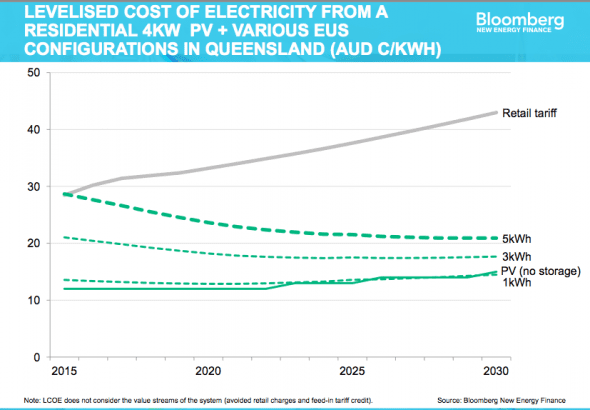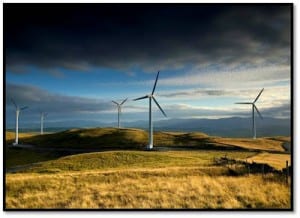
by
Giles Parkinson, Renew Economy:
http://reneweconomy.com.au/2015/shorten-slams-coalition-flat-earthers-as-incumbents-bite-back-96312
Labor
leader Bill Shorten appears to have rediscovered his and the party’s
climate change mojo - promising an emissions trading scheme, a 50% renewable energy target, and slamming Tony Abbott’s society of
“flat Earthers”.
Shorten, in his speech to the Labor national conference in Melbourne,
described the attacks on wind energy by Abbott and Treasurer Joe Hockey
as “grotesque”.
He said he wanted more solar panels on Australian rooftops - homes,
schools, shops and businesses. He said these would help cut power bills
for consumers and put electricity back into the grid. But he also wanted
to help accelerate the deployment of battery storage.
“2014 was the warmest year in recorded history,” Shorten said. “The
evidence is in, the science is settled. Climate change is not ‘absolute
crap’, it is an inescapable fact. And if we take a do-nothing approach,
there will be more extreme weather.”
To which he added later: “Climate change is an economic and
environmental cancer - and it demands early intervention. Mark Butler is
right, this is no longer a question of Australia leading the world - it
is a matter of keeping up.
“If the world’s biggest capitalist nation, and the world’s biggest
planned economy can agree climate change is a priority - it’s time
Australia did so too. Mr Abbott’s society of flat-earthers talk a lot of nonsense about
Labor policies - but they’re right about one thing. There is,
absolutely, a clear-cut choice between Labor and the Liberals on
renewable energy. Mr Abbott is a throwback to a world that never existed … out of his
depth, and out of touch. Australians deserve better than a prime
minister who wants to make them afraid of the future.”
Shorten appears to have polling on his side - numerous polls suggest
that the Australian population is warming to the idea of more ambitious
renewable energy policies, and although there is suggestion that an
electricity price scare campaign could get traction, there is now the
prospect that the two major parties will go to a poll with distinctive
climate change and renewable energy policies; for the first time since
2007 when John Howard was forced to rapidly adopt similar policies in a
failed attempt to stop the Kevin Rudd juggernaut.
Right now, it seems, the Abbott government is seeking to entrench its
rearguard position - no carbon price, no increase in renewables, and a
big scare campaign. Indeed, environment minister Greg Hunt, who is
leading the price campaign, has said the Coalition’s renewables support
will cease in 2020.
The scale of the resistance from vested interests has been
highlighted by the response to Shorten’s 50% renewable energy
plans from the energy industry, big business, and the Murdoch Media. All are fighting against the idea that coal-fired power stations
should close early - at least without major handouts - or that networks
should be written down to recognise the fact that ageing assets are
being rapidly overtaken by newer, smarter, cheaper technologies.
The Energy Users Association, which represents manufacturers and
retailers, said it doubted that Australia could effect such a change,
and the policy “ignored the operations of our unique electricity market”
which was built on “the back of inexpensive and available energy
sources.”
It refused to entertain a write-down of network values, and said
houses installing solar and battery storage were simply adding costs to
other users. “These assets cannot be junked, cannot be quickly written off and are
paid for by consumers and users still in the system,” said EUA CEO
Phil Barresi.
The Energy Supply Association of Australia, which represents networks
and power generators, has also reacted fiercely against the proposed
Labor platform, particularly the idea of encouraging more renewable
energy.
The Murdoch media continued its assault on the policy, with some
commentators again dismissing the science of climate change as a hoax,
and
The Australian‘s economics writer, Adam Creighton, suggesting that the current coal-heavy energy mix was entirely “satisfactory”.
In an extraordinary column, Creighton borrowed a glad-bag full of the
Coalition’s talking points about the supposed costs and impacts of
renewable energy, dismissed wind turbine manufacturers as “rent seekers”
and described renewable energy as a “religion”. His proposal is to
“spend nothing” on the energy market and leave coal generators
untouched.
The question none of them answer is how Australia proposes to
maintain its fleet of ageing coal-fired generation and keep a lid on
costs of doing that, and address carbon emissions. Shorten, however, said that Labor would not be sidelined by such
campaigns - as it clearly had been in 2010 when it dumped the carbon
price and began a bitter and protracted leadership battle that saw two
leaders fall.
“And if Mr Abbott wants to make the next election a contest about who
has the best policy solution for climate change … I’ve got a
three-word-slogan for him: Bring.It.On.”
Here is Shorten’s speech in full, or at least the bit on climate change and energy policy:
CLIMATE CHANGE
“Creating the jobs of the future, guaranteeing long-term prosperity,
ensuring Australia competes in the world must begin with tackling
climate change. Fourteen of the fifteen warmest years on record have fallen in this century. 2014 was the warmest year in recorded history. The evidence is in, the science is settled.
Climate change is not ‘
absolute crap’, it is an inescapable fact. And if we take a do-nothing approach, there will be more extreme weather. More severe storms, more aggressive fires, more dangerous floods, longer and more damaging droughts. Our farmers will face greater hardship. Our coastal homes will be invaded by rising seas. The infrastructure cost will be hundreds of billions of dollars.
Delegates, we can rebuild flooded cities once every century. We can rebuild fire-ravaged bushland every half-century. But we cannot do it every decade. This is not a price the next generation of Australians should have to pay because of this delinquent government.
Climate change is an economic and environmental cancer - and it demands early intervention. Mark Butler is right, this is no longer a question of Australia leading the world - it is a matter of keeping up. If the world’s biggest capitalist nation, and the world’s biggest
planned economy can agree climate change is a priority - it’s time
Australia did so too.
Mr Abbott’s society of flat-earthers talk a lot of nonsense about Labor policies - but they’re right about one thing. There is, absolutely, a clear-cut choice between Labor and the Liberals on renewable energy.
This Coalition government has done everything in their power to try
and destroy Australia’s share in one of the world’s fastest growing
industries. The Abbott-Hockey attacks on renewables are grotesque - and the consequences have been devastating.
Last year, around the world, investment in renewables rose by 16%. In China alone, up by 33%. In Australia,
down by 88%. Only a Labor Government can save the renewable energy industry now. Only Labor can restore the confidence and certainty this government has smashed. This is why, in our platform we must set an ambitious new goal for renewable energy.
By 2030, our aim is for renewable energy to generate 50% of Australia’s electricity. This is how we transform our electricity system, build a new industrial landscape and deliver a clean energy future. I want to see more solar panels on Australian rooftops. On our homes, our schools, our shops and businesses … cutting power bills for consumers and putting electricity back into the national grid.
I want us to develop and apply battery technology, so power from solar panels can be stored in our homes, more efficiently. I want more Aussie farmers, earning more money, by putting wind turbines on their land. I want more investors to have the confidence to create more jobs. And I want Australia to get our fair share of the $2.5 trillion in investment expected in Asia-Pacific renewables to 2030.
A Labor Government will work with businesses and unions to look after workers affected by modernisation … helping with re-training and re-skilling for new opportunities in new industries, as Australians find new ways to live.
Friends, boosting renewable energy is at the heart of Labor’s plan to cut pollution. And instead of giving big polluters fistfuls of taxpayer dollars to
keep polluting … Labor will cut pollution with a market solution. A billion people, and more than 40% of the world’s economy
have already embraced the opportunities of emissions trading schemes. We must give Australian businesses the opportunity to engage with this global market.
This is the promise I offer our nation, today. A Shorten Labor Government will build an Emissions Trading Scheme for Australia. And we will not be intimidated by the ignorant, ridiculous scare campaigns that will come. We will win this fight.
Let me say this to our opponents, in words of one syllable: An E.T.S is not a tax. And if Mr Abbott wants to make the next election a contest about who has the best policy solution for climate change … I’ve got a three-word-slogan for him: Bring.It.On.”



















